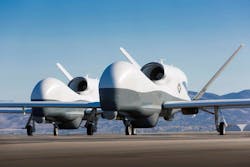Maritime authorities consider future modes of wide-area ocean persistent surveillance to enhance intelligence
WASHINGTON – Persistent surveillance is a term from a Navy, Marine Corps, and Coast Guard military strategy document exploring new dimensions of maritime warfare. It describes an insatiable appetite for intelligence, surveillance, and reconnaissance. Kris Osborn at The National Interest reports. Continue reading original article
The Military & Aerospace Electronics take:
16 March 2021 -- The new strategy discusses possibilities for armed unmanned aerial vehicles (UAVs), undersea sensing and attack, and overhead wide-area ocean surveillance from manned and unmanned aircraft.
It could involve massive numbers of unmanned undersea vehicles (UUVs), unmanned surface vessels (USVs), and manned and unmanned aircraft. One important player is the P-8 Poseidon maritime patrol jet. The document explains that surveillance technologies will help combine information into a common, actionable operational picture to enable U.S. forces to act more quickly than their adversaries.
This wide-area ocean surveillance approach relies on advanced command and control, dispersed networked forces, artificial intelligence (AI), and virtually every kind of unmanned system. The Navy MQ-4C Triton long-range UAV, for example, has high-altitude sensors. New data AI-enabled analysis might make platforms like the MQ-4C Triton as capable as the much larger manned P-8 Poseidon.
John Keller, chief editor
Military & Aerospace Electronics
